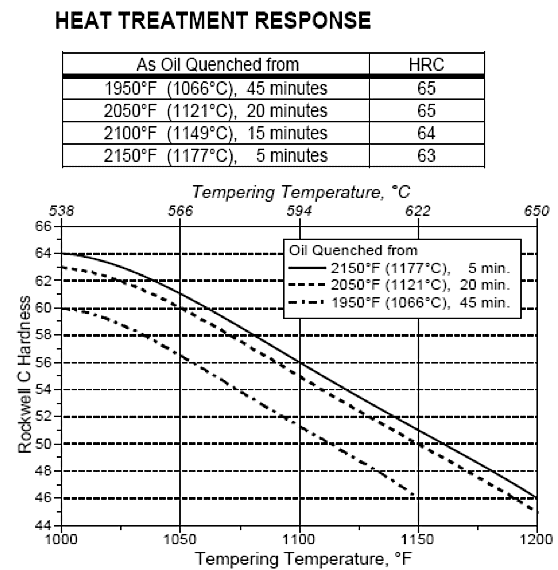A11 PM
Download A11 PM Spec sheetWM A-11 powder metal tool steel is a versatile tool and die steel which provides extremely high wear resistance in combination with relatively high impact toughness. A large volume of hard vanadium carbides provides the high wear resistance. The good impact toughness is a result of the fine grain size, small carbides, and superior cleanliness of the powder metallurgy (PM) microstructure. WM A-11 offers substantially better wear resistance than the high-carbon, high-chromium die steels such as D2 and D7.
CHEMICAL COMPOSITION
| Carbon | 2.45 |
| Manganese | 0.50 |
| Silicon | 0.90 |
| Chromium | 5.25 |
| Molybdenum | 1.30 |
| Vanadium | 9.75 |
PHYSICAL PROPERTIES
Density – 0.268 lb/in3
Specific gravity – 7.41
Coefficient of Thermal Expansion
| 70 – 200°F | 5.96 x 10-6 in/in/°F |
| 70 – 500°F | 6.18 |
| 70 – 800°F | 6.54 |
| 70 – 1100°F | 6.82 |
Critical Temperature:
Ac1: 1540°F
PREHEATING
AUSTENITIZING (high heat)
For Optimum Wear Resistance:
Soak for 5 to 15 minutes.
Furnace or Salt Bath: 2150°F
For Balance of Wear Resistance and Toughness:
Soak for 15 to 30 minutes.
Furnace or Salt Bath: 2050°F
For Maximum Toughness and minimum distortion in cooling:
Soak for 30 to 60 minutes.
Furnace: 1975°F
Salt Bath: 1950°F
QUENCHING
For pressurized gas, the furnace should have a minimum quench pressure of 4 bars. The quench rate to below 1000°F is critical to obtain the desired properties.
For oil, quench until black, about 900°F then cool in still air to 150-125°F.
For salt maintained at 1000-1100°F equalize in the salt, then cool in still air to 150-125°F.
TEMPERING
The typical tempering range is 1000-1100°F. Do not temper below 1000°F. Hold at temperature for 2 hours then air cool to ambient temperature. Double tempering is required. Triple tempering is required when austenitized at 2100°F.

ANNEALING
Heat at a rate not exceeding 400°F per hour to 1600-1650°F, and hold at temperature for 1 hour per inch of maximum thickness; 2 hours minimum. Then cool slowly with the furnace at a rate not exceeding 30°F per hour to 1000°F. Continue cooling to ambient temperature in the furnace or in air. The resultant hardness should be a maximum of 277 HBW.




